軟件工程綜合實踐(2)
軟件工程綜合實踐(2)
LoginAction 到底做了什麽?
1. 通過String username = request.getParameter("username");
獲取了頁面當中輸入的用戶名
2. 有可能獲取到亂碼,那可以通過
username = new String (username.getBytes("ISO-8859-1"),"utf-8");
轉碼 如果 獲取的信息不是亂碼,那你就不要轉碼了,否則會轉換成亂碼
3. 判斷一下是否能登陸(獲取的用戶名和密碼是否都匹配)
if("neusoft".equals(username)&&"123".equals(pwd))
4. WEB-INF下的jsp頁面不能直接跳轉,需要通過
request.getRequestDispatcher("WEB-INF/jsp/success.jsp").forward(request, response);
轉發,才能夠跳轉
5. request.getRequestDispatcher 可以攜帶 request.setAttribute的信息
6. Request轉發之後的頁面,可以通過el表達式獲取setAttribute的信息
${uname } 註意 uname 是
request.setAttribute("uname", username);這個方法中的uname
7. Response 是 重定向,不能攜帶數據
8. Session裏面的數據 response 和 request 都能傳遞
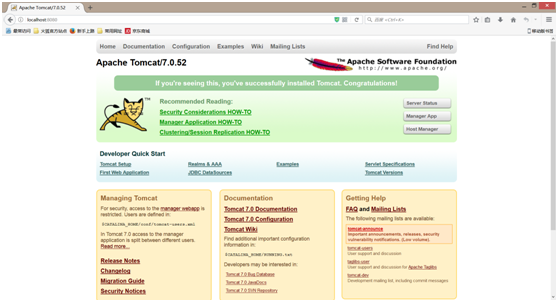
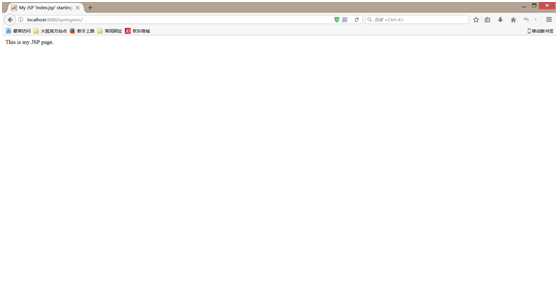
<%@ page language="java" import="java.util.*" pageEncoding="utf-8"%> <% String path = request.getContextPath(); String basePath = request.getScheme()+"://"+request.getServerName()+":"+request.getServerPort()+path+"/"; %> <!DOCTYPE HTML PUBLIC "-//W3C//DTD HTML 4.01 Transitional//EN"> <html> <head> <base href="<%=basePath%>"> <title>My JSP ‘index.jsp‘ starting page</title> <meta http-equiv="pragma" content="no-cache"> <meta http-equiv="cache-control" content="no-cache"> <meta http-equiv="expires" content="0"> <meta http-equiv="keywords" content="keyword1,keyword2,keyword3"> <meta http-equiv="description" content="This is my page"> <!-- <link rel="stylesheet" type="text/css" href="styles.css"> --> </head> <body> <a href="login.jsp">登陸</a> </body> </html>
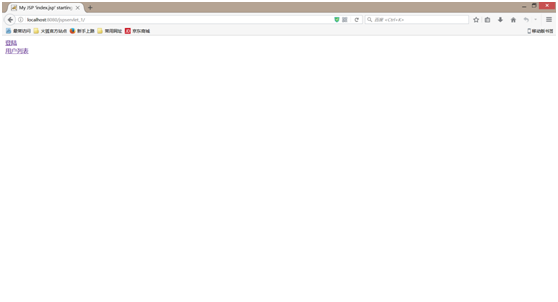
\
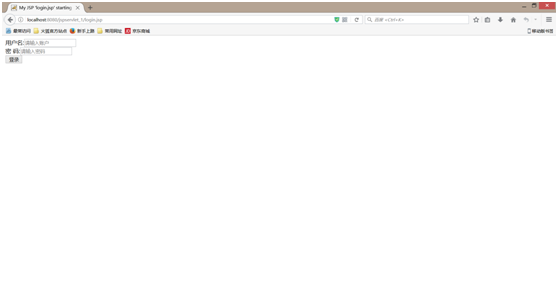
<%@ page language="java" import="java.util.*" pageEncoding="utf-8"%> <% String path = request.getContextPath(); String basePath = request.getScheme()+"://"+request.getServerName()+":"+request.getServerPort()+path+"/"; %> <!DOCTYPE HTML PUBLIC "-//W3C//DTD HTML 4.01 Transitional//EN"> <html> <head> <base href="<%=basePath%>"> <title>My JSP ‘login.jsp‘ starting page</title> <meta http-equiv="pragma" content="no-cache"> <meta http-equiv="cache-control" content="no-cache"> <meta http-equiv="expires" content="0"> <meta http-equiv="keywords" content="keyword1,keyword2,keyword3"> <meta http-equiv="description" content="This is my page"> <!-- <link rel="stylesheet" type="text/css" href="styles.css"> --> </head> <body> <form action="LoginAction" method="get"> 用戶名:<input type="text" name="username" id="username" placeholder="請輸入賬戶" required="required"/> <font color="red">${unameErr }</font> <br/> 密 碼:<input type="password" name="pwd" id="pwd" placeholder="請輸入密碼" required="required"/> <font color="red">${pwdErr }</font> <br/> <input type="submit" value="登錄"/> </form> </body> </html>
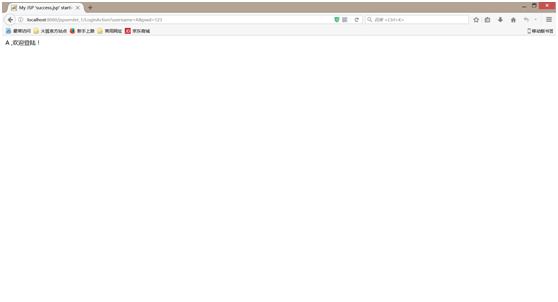
<%@ page language="java" import="java.util.*" pageEncoding="utf-8"%> <%@ taglib prefix="c" uri="http://java.sun.com/jsp/jstl/core" %> <% String path = request.getContextPath(); String basePath = request.getScheme()+"://"+request.getServerName()+":"+request.getServerPort()+path+"/"; %> <!DOCTYPE HTML PUBLIC "-//W3C//DTD HTML 4.01 Transitional//EN"> <html> <head> <base href="<%=basePath%>"> <title>My JSP ‘users.jsp‘ starting page</title> <meta http-equiv="pragma" content="no-cache"> <meta http-equiv="cache-control" content="no-cache"> <meta http-equiv="expires" content="0"> <meta http-equiv="keywords" content="keyword1,keyword2,keyword3"> <meta http-equiv="description" content="This is my page"> <!-- <link rel="stylesheet" type="text/css" href="styles.css"> --> </head> <body> <center> <h1>用戶列表</h1> <table border="1"> <tr> <td>用戶編號</td> <td>用戶名</td> <td>密碼</td> </tr> <!-- 第二行開始要作信息顯示了,信息比較多,我們使用循環 --> <c:forEach items="${users }" var="d"> <tr> <!-- ${d.userid } ,後面的userid 是 Userinfo 實體類中 屬性的名字,這裏 必須完全對應,大小寫完全一致 --> <td><a href="#">${d.userid }</a></td> <td>${d.username }</td> <td>${d.pwd }</td> </tr> </c:forEach> </table> </center> </body> </html>
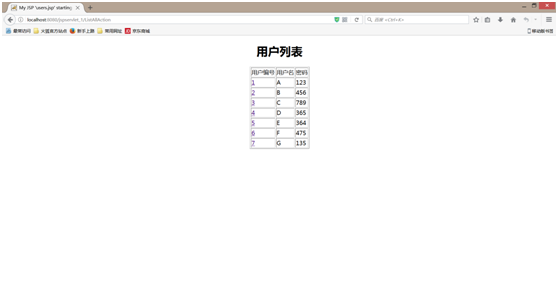


<?xml version="1.0" encoding="UTF-8"?> <web-app version="2.5" xmlns="http://java.sun.com/xml/ns/javaee" xmlns:xsi="http://www.w3.org/2001/XMLSchema-instance" xsi:schemaLocation="http://java.sun.com/xml/ns/javaee http://java.sun.com/xml/ns/javaee/web-app_2_5.xsd"> <display-name></display-name> <!-- springmvc 前端控制器配置 --> <servlet> <servlet-name>springmvc</servlet-name> <servlet-class>org.springframework.web.servlet.DispatcherServlet</servlet-class> <!-- springmvc.xml 具體進行配置,這裏我們只是讀取配置文件 --> <init-param> <param-name>contextConfigLocation</param-name> <param-value>classpath:springmvc.xml</param-value> </init-param> </servlet> <servlet-mapping> <!-- 第一種 *.action 只有訪問到 springmvc/login.action 有.action才觸發 springmvc 第二種 / 符合現在網頁的url 樣式 RESTful風格 第三種 /* 最好不要使用 最終處理完需要跳轉到一個jsp 代表所有的內容都會經過 DispatcherServlet 再解析jsp 會報錯 --> <servlet-name>springmvc</servlet-name> <url-pattern>*.action</url-pattern> </servlet-mapping> <welcome-file-list> <welcome-file>index.jsp</welcome-file> </welcome-file-list> </web-app>
<beans xmlns="http://www.springframework.org/schema/beans" xmlns:xsi="http://www.w3.org/2001/XMLSchema-instance" xmlns:mvc="http://www.springframework.org/schema/mvc" xmlns:context="http://www.springframework.org/schema/context" xmlns:aop="http://www.springframework.org/schema/aop" xmlns:tx="http://www.springframework.org/schema/tx" xsi:schemaLocation="http://www.springframework.org/schema/beans http://www.springframework.org/schema/beans/spring-beans-3.2.xsd http://www.springframework.org/schema/mvc http://www.springframework.org/schema/mvc/spring-mvc-3.2.xsd http://www.springframework.org/schema/context http://www.springframework.org/schema/context/spring-context-3.2.xsd http://www.springframework.org/schema/aop http://www.springframework.org/schema/aop/spring-aop-3.2.xsd http://www.springframework.org/schema/tx http://www.springframework.org/schema/tx/spring-tx-3.2.xsd "> <!-- 配置Controller --> <bean id="UsersController1" name="/users.action" class="cn.neusoft.controller.UsersController1"></bean> <!-- 項目中一般使用 掃描包的方式 進行 配置 --> <context:component-scan base-package="cn.neusoft.controller.UsersController"></context:component-scan> <!-- 實際開發中使用 加載註釋的 適配器、映射器 Json轉換器 --> <mvc:anotation-driven></mvc:anotation-driven> <!-- 非註解的 映射器 以及 適配器 --> <!-- 配置處理器映射器 --> <bean class="org.springframework.web.servlet.handler.BeanNameUrlHandlerMapping"></bean> <!-- 配置處理器適配器 --> <bean class="org.springframework.web.servlet.mvc.SimpleControllerHandlerAdapter"></bean> <!-- 另外一個適配器 --> <bean class="org.springframework.web.servlet.mvc.HttpRequestHandlerAdapter "></bean> <!-- 配置視圖解析器 --> <bean class="org.springframework.web.servlet.view.InternalResourceViewResolver"> <!-- 配置jsp 的頁面的前綴 --> <property name="prefix" value="/WEB-INF/jsp"></property> <!-- 配置後綴 --> <property name="suffix" value=".jsp"></property> </bean> </beans>
在Mybatis的學習之後,我們學習了前端代碼,Javaservlet和springmvc,在寫代碼之前首先要將"ISO-8859-1"修改為"utf-8",否則會出現亂碼。以及,一開始無法連接服務器時,要進行Tomcat的配置。
springmvc是spring框架的一個模塊,springmvc和spring無需通過中間整合層進行整合。springmvc是一個基於mvc的web框架。
Spring為展現層提供的基於MVC設計理念的優秀的Web框架,是目前最主流的MVC框架之一
Spring3.0後全面超越Struts2,成為最優秀的MVC框架
SpringMVC通過一套MVC註解,讓POJO成為處理請求的控制器,而無須實現任何接口
支持REST風格的URL請求
采用了松散耦合可插拔組件結構,比其他MVC框架更具擴展性和靈活性
軟件工程綜合實踐(2)
